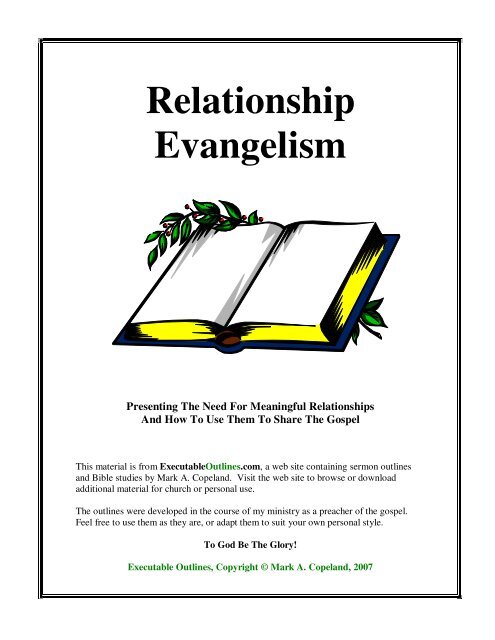PDF file - Executable Outlines
PDF file - Executable Outlines
PDF file - Executable Outlines
Create successful ePaper yourself
Turn your PDF publications into a flip-book with our unique Google optimized e-Paper software.
Mark A. CopelandTO PEOPLE...1. Since we cannot possibly recognize or relate to every one, we are tempted to relate to noone!2. Before long, we begin to adopt an attitude of “isolation”3. Eventually, we lose the ability to effectively carry on meaningful relationshipsC. THIS CAN HAVE AN ADVERSE EFFECT ON EVANGELISM...1. For a meaningful relationship is one of the most successful means of providing an avenue forthe gospel (which is the thesis of this study)2. But many Christians, caught up in the attitude of “isolationism”...a. Often do not have any significant contacts with non-Christiansb. Are therefore unable to relate to others in a “redemptive” mannerII. LIFE IS TOO FAST AND COMPLICATEDA. DESPITE INVENTIONS TO SAVE TIME, WE ARE BUSIER THAN EVER...1. Jobs change, people move2. Congestion grows, traffic jams3. Telephones ring constantly, TV drones on and on4. We are held captive by schedules and the demands of others5. We find ourselves unable to slow down our world...B. LIVING SUCH HECTIC LIVES...1. It is easy for one to feel there is simply no room to add the “enterprise of evangelism”2. One might feel that to do so may even be “the straw that breaks the camel’s back”3. So evangelism of any sort is often left outIII. EXPOSURE TO LIMITED EVANGELISM MODELSA. EVEN WHEN WE WANT TO DO SOMETHING, WE ARE OFTEN GIVENLIMITED “OPTIONS”...1. Such as just inviting people to services2. Or going around the neighborhood, knocking on the doors of complete strangers3. Or learning how to teach home Bible studiesB. THIS IS NOT TO SAY THAT SUCH METHODS HAVE NOT WORKED OR WILLNOT WORK FOR SOME...1. These options do work for some Christians, but not all are suited for the particularapproaches given2. These options do reach some nonbelievers, but many are repelled by themC. BUT THERE CAN BE LONG-LASTING EFFECTS WHEN THESE ARE THEONLY OPTIONS GIVEN...1. Those not suited for these approaches can get easily discouraged as they try and findthemselves failing to be something they are not2. E.g., not everyone is designed to be a teacher - cf. Ro 12:4-8; 1 Co 12:29; Ja 3:13. So unless other options are shown to be available, many quit making any evangelistic effort!IV. MISUNDERSTANDING “SEPARATION”Relationship Evangelism 4
Mark A. CopelandA. MANY CHRISTIANS MISUNDERSTAND THE PRINCIPLE OF SEPARATION...1. We are to be “separate” from the world - cf. 2 Co 6:14-182. But this does not mean “isolation” - cf. 1 Co 5:9-133. Yet I fear that many Christians tend to isolate themselves from the world in the name of“separation”4. There is a way to “influence people without losing your influence!”B. REMEMBER THE PRINCIPLE OF BEING “THE SALT OF THE EARTH”...1. Salt must get out of the container and mix with food to be effective2. Without engaging in sin, we can still have contact with the sinner...a. As did Jesus - Mt 9:10-13; 11:19b. And so did Paul - 1 Co 9:20-23V. THE CREDIBILITY GAPA. IN SOME CASES, THERE IS AN IMBALANCE BETWEEN THE“VERBALIZATION” AND THE “INCARNATION” OF THE GOSPEL...1. I.e., the lifestyle of the Christian is inconsistent with the message being presented2. When this happens, people are likely to think: “What you are speaks so loudly, I can’thear what you are saying.”3. In this way, a “credibility gap” is formedB. TO OVERCOME THIS “CREDIBILITY GAP”...1. Christians must be good news before they can share the good news2. We must be sure to live out the gospel in our lives before preaching it to others - cf. Ezra7:10; 1 Pe 3:1-2C. TO PUT IT ANOTHER WAY...1. When love is seen, the message is heard2. Conversely, when love is not seen, the message is not taken seriously3. “The best argument for Christianity is Christians; their joy, their certainty, theircompleteness. But the strongest argument against Christianity is also Christians -- whenthey are somber and joyless, when they are self-righteous and smug in complacentconsecrations, when they are narrow and repressive, then Christianity dies a thousanddeaths.” - VanaukenCONCLUSION1. These are some of the forces which hinder our effectiveness in evangelism today2. Again, the purpose for considering them is not to excuse ourselves...a. For no matter what the circumstances here on earth, the Lord’s plan for reaching the lost is stillthe same!b. He still depends upon you and me!3. But perhaps by recognizing these hindrances, we will be more open to other evangelistic optionswhich take these problems into considerationRelationship Evangelism 5
Mark A. CopelandOne such option is known as Relationship Evangelism (also known as Lifestyle Evangelism), which iswhat we shall examine more closely in succeeding lessons...Relationship Evangelism 6
INTRODUCTIONRelationship EvangelismDefinition And Value Of Relationship EvangelismMark A. Copeland1. In our initial study, we examined some of the forces which hinder our effectiveness in evangelism...a. Too many peopleb. Life is too fast and complicatedc. Our exposure to limited evangelism modelsd. Misunderstanding “separation”e. The credibility gap2. One approach to evangelism which takes these forces into consideration is RelationshipEvangelism (also known as Lifestyle Evangelism)3. The purpose in this lesson is to define what “Relationship Evangelism” is, and then notice its valuein comparison to other methods of evangelismI. THE DEFINITION OF RELATIONSHIP EVANGELISMA. THE CHRISTIAN HAS BEEN PROVIDED WITH TWO PRIMARY MEANS TOWIN THE WORLD TO CHRIST...1. First and foremost is the message of the gospel of Christ - Ro 1:162. But there is also the manifestation of the gospel in the life of the Christian - cf. 1 Pe 3:1-2B. “RELATIONSHIP EVANGELISM,” THEN, IS...1. Adapting the two means to the best advantage for those we seek to lead to Christ2. A process of developing meaningful relationships with other people...a. In which we allow the beauty of the gospel to first be demonstrated in our livesb. In which we build bridges (develop relationships) with our prospects that allow thetraffic (i.e., the gospel) to flow freely and naturally3. That which involves gradually developing relationships with those who are lost...a. By working with an unlimited pool of contacts (family, friends, neighbors, coworkers)b. By normally starting with those closest to us and working outward in “concentric circlesof concern”4. The development of relationships that involve several progressive levels...a) The initial contactb) Becoming better acquaintedc) Being a servantd) Being a friende) Sharing your faithf) Witness of the “Body”g) Exposure to the gospelh) Invitation-- These will be covered in more detail in succeeding lessons[Therefore, Relationship Evangelism is where we have enough love and concern for the lost...Relationship Evangelism 7
Mark A. Copeland That we are willing to make the effort to develop relationships with them So that we can by both “word” and “example” share the gospel of Christ with themWhat value does this approach have over others?]II. THE VALUE OF RELATIONSHIP EVANGELISMA. ITS EFFECT ON OUR OWN LIVES...1. Relationship Evangelism requires that our spiritual growth and development be what itshould be!a. Other forms of evangelism (e.g., preaching, door-knocking, correspondence courses,etc.) can be utilized by hypocrites or those less than truly dedicated Christiansb. But to be effective in Relationship Evangelism our lives must be:1) “An open book”2) “Rated G”3) “...an epistle of Christ, known and read by all men.” - cf. 2 Co 3:2-32. So by adopting this approach to evangelism, it will:a. Motivate us to draw closer to Godb. Make us better ChristiansB. ITS EFFECT ON THE LIVES OF NON-CHRISTIANS...1. Relationship Evangelism gets us out of the church building, into the lives of those whoare losta. Where we can be “salt” and “light”b. Where we can humbly demonstrate a better way of life2. Adopting this approach to evangelism can:a. Make our neighborhoods a better place in which to liveb. Improve the moral environment in our places of employmentC. ITS SUCCESS...1. What may have worked well in times past may not today because of changing conditionsa. It used to be that the majority of Americans were of a “Christian” background1) Though non-Christians, they held to basic Christian morals and beliefs (God, theBible, the Judgment, etc.)2) In such cases, a simple presentation of the gospel was often all that was needed3) But today, the majority is now what can be called “secular, or other religion”backgrounda) I.e., worldly-minded, or holding to non-Christian religions, they do not hold tobasic Christian morals and beliefsb) In such cases, a lot of preparation of the “soil” must sometimes be made priorto the planting of the “seed”b. It used to be that most Christians knew how to easily develop new relationships withother people1) Many Christians had close friends, associates, who though of a “Christian”background were like Apollos - cf. Ac 18:24-262) In such relationships, it was easy to discuss religious differences over a period oftime without breaking off all contact after a few disagreementsRelationship Evangelism 8
Mark A. Copeland3) But due to the hindrances mentioned in our first lesson, many Christians todaydon’t have such relationships, and don’t know how to be close friends with those ofdifferent faithsc. Again, Relationship Evangelism takes these changing conditions into consideration2. In his book, “Why Churches Grow,” Flavil Yeakley made the following observationsbased upon his study of growing and dying churches:a. “The data presented in these tables strongly support the idea that establishment of apattern of friendship is an important part of the conversion process.” (p. 64)b. “Thus the Christ who lives in the heart of the individual members of that congregation isformed in the heart of the new convert. A personal relationship is essential in theprocess.” (p. 53)c. “These data suggest that when subjects formed personal relationships with members ofthe congregation, they were likely to remain faithful. When they did not form suchpersonal relationships, they were likely to drop out of the church.” (p.54)d. I.e., where a personal relationship was used as a vehicle to present the gospel...1) A person is more likely to convert to Christ2) A person is more likely to remain converted to Christ3. Finally, consider the results of a survey by The Institute For American Church Growth,who asked over 10,000 people this question: “What was responsible for your coming toChrist and this church?” - Their replies:a. I had a special need - 2%b. I just walked in - 3%c. I like the minister - 6%d. I visited there - 1%e. I like the Bible classes - 5%f. I attended a gospel meeting - 0.5%g. I liked the programs - 3%h. A friend or relative invited me - 79%CONCLUSION1. I am not suggesting that Relationship Evangelism is the only way to do personal worka. Many souls have been brought to Christ through other meansb. It may be that you are more suited to use other methods2. But Relationship Evangelism is a viable option which...a. Takes into consideration some of the forces which hinder our effectiveness in evangelismb. Makes us better Christians in the process of trying to influence the lostc. Is an easy, natural, less confrontational way to share the gospel with othersd. Is more likely to be successful in leading souls to Christ and keeping them faithful to the Lord!In the next lesson, we will discuss The Evangelism Prospect List, a helpful tool in developingrelationships with non-Christians...NOTE: At this point the material in this series might best be used by Christians in a weekly class inwhich they meet to: Study and discuss the remaining materialRelationship Evangelism 9
Encourage one another to set weekly goals for implementing the suggestions that willbe made in later lessons Evaluate the success or failure to meet such goals and make whatever alterations maybe deemed suitable in setting new goalsMark A. CopelandRelationship Evangelism 10
Relationship EvangelismThe Evangelism Prospect ListMark A. CopelandINTRODUCTION1. Up to this point, we have been dealing with the preliminaries of Relationship Evangelism2. With this lesson we start getting into practical applications3. One of the first steps to successful evangelism using any method is to have an EvangelismProspect List[This is especially true in Relationship Evangelism...]I. WHAT IS AN EVANGELISM PROSPECT LIST?A. SIMPLY STATED, IT IS A LIST OF NAMES...1. Of individuals that we would like to see saved2. Which we keep in some prominent place where we see it every dayB. IN THE CASE OF RELATIONSHIP EVANGELISM...1. The prospect list is a part of the Evangelistic Prospect Flow Chart (see sample)2. The “Flow Chart” will be explained in more detail in succeeding lessons, but you will noticethat it provides space for the names of those who would be on your listII. WHY HAVE AN EVANGELISM PROSPECT LIST?A. AN IMPORTANT KEY TO LEADING PEOPLE TO CHRIST IS CONSTANTLYKEEPING THEM ON YOUR MIND AND IN YOUR PRAYERS - cf. Ro 10:11. Consistent success in any venture depends upon...a. Setting goals (which gives direction to your life)b. Keeping those goals constantly before you (which provides motivation to your actions)2. To be successful in evangelism...a. We need goals to give us a directionb. We need to be constantly reminded of those goals to stay motivatedB. THE EVANGELISM PROSPECT LIST IS A HELPFUL TOOL TO ACCOMPLISHTHIS END...1. By having a specific list of names we are able to concentrate our attention and our prayers2. By having that list in some prominent place, we are constantly reminded of our goal to reachthem for Christ3. It is like having a picture on the refrigerator to motivate us not to overeatIII. SUGGESTIONS FOR SETTING UP YOUR EVANGELISM PROSPECT LISTA. PRAY FOR WISDOM - cf. Ja 1:51. Once we start listing prospects, it will be evident that to work effectively the list needs to beRelationship Evangelism 11
Mark A. Copelandnarrowed down2. So wisdom (which can be sought through prayer) will be helpful to determine the bestprospectsB. LIST THE NAMES OF YOUR NON-CHRISTIAN CONTACTS...1. Here are some good sources for prospects:a. Visitors at servicesb. Spouses of membersc. New residents in the neighborhoodd. Relatives of memberse. Unfaithful membersf. Friends of membersg. Your own neighbors, friendsh. Coworkersi. Children of membersj. Prospects furnished by recent convertsk. Classmates at school2. Initially, concentrate on just developing the lista. Add names to the list over a period of time as other prospects come to mindb. If you have trouble coming up with any names...1) Don’t get discouraged, it has become very easy for each of us to become isolated inour own little world2) The next lesson will suggest ways to make initial contacts so you will begin to haveprospectsC. SIFT THROUGH YOUR LIST TO DETERMINE WHICH TO GIVE PRIORITY...Some guidelines for determining priority:1. Those you believe are closest to obeying the gospel2. Those with whom you have open communication3. Those who have shown spiritual interest (but are “unchurched”)4. Those whose respect and friendship you have gained5. Those for whom you have been praying regularly6. Those you may have a limited time to reach...a. Who might be moving from your areab. Or who might not have long to live7. Those who have a Christian spouse8. Those in whom others have already invested some “sowing” and “watering”9. Those who seem to repeatedly come across your path (is it coincidence, or providence?)10. Those for whom you have the greatest concernD. NARROW YOUR LIST DOWN TO NO MORE THAN TEN PEOPLE...1. These will be the people you feel are your best prospects2. Put their names on a list (such as the Evangelistic Prospect Flow Chart)3. Keep this list in some prominent place where you will see it dailyE. BEGIN PRAYING FOR THESE PEOPLE DAILY...1. Asking God for opportunity to be of service to these people - cf. 1 Co 3:5-7; Co 4:32. Asking God for wisdom to make the most of the opportunities you have - cf. Co 4:4-63. Asking God for boldness to share the gospel when the right opportunity avails itself - cf. EpRelationship Evangelism 12
6:18-20Mark A. CopelandCONCLUSION1. Developing such a list can be a major step to being successful in reaching others to Christ2. As with so many areas of life, the reason many individuals fail to achieve their goals in life isbecausethey never really set them in the first place!3. But if our goal in life is to save others, an Evangelism Prospect List (as incorporated in theEvangelistic Prospect Flow Chart) can help to define our goals and keep them ever before us4. In the next lesson we will explain further the Evangelistic Prospect Flow Chart and offersuggestions on how to develop meaningful relationships with those outside of ChristBut if you have time between now and the next lesson... Come up with as many as ten names of people you would like to see saved List them on the “Flow Chart” Begin praying for them daily Be prepared to share with others the names you have on your prospect listEven if you do nothing more than develop such a list and begin praying for the souls on this list, perhapsyou can give a copy of it to some teacher or preacher who can follow up on it!Relationship Evangelism 13
INTRODUCTIONRelationship EvangelismBuilding Bridges (Developing Relationships)Mark A. Copeland1. Before beginning this lesson...a. Spend a few moments sharing with one another your lists of prospects for which you have beenprayingb. As a group, take the time to pray in behalf of these souls...1) Asking God to be with them2) Asking God to bless your efforts to set before them the proper example, and to one dayreach them with the gospel of Christ2. As stressed thus far in this study, the key to Relationship Evangelism is developing meaningfulrelationship in which we can increase opportunities to share the gospel3. But as pointed out in the first lesson, there are factors which hinder our effectiveness:a. Too many people - tempting us to relate to no one since we can’t possibly relate to everyoneb. Misunderstanding separation - causing us to become isolated from many in the world4. The end result of such factors is that many Christians no longer know how to develop meaningfulrelationships with new people!a. We have forgotten how to “make friends”b. Like someone who has been married so long that when widowed they have forgotten how to“go on a date”5. The Evangelism Prospect Flow Chart is a tool for developing meaningful relationships...a. To those we hope to reach with the gospel, it can help us to “Build Bridges” (developrelationships)b. Later, we shall see how it can help us to “Let The Traffic Flow” (use the relationship to sharethe gospel)6. Before we examine the four stages of “Building Bridges,” consider the following explanation ofthe Flow Chart...a. The Flow Chart is a tool to aid one in developing relationships with others which we hope willresult in their obeying the gospel of Christb. As you gradually progress through the eight stages of developing a relationship, mark theappropriate box, indicating that the particular level of the relationship has been attainedc. In some cases, more time will be spent at one stage more than anotherd. Also, in some cases the stages might be attained in an order slightly different than shown on thecharte. The important point is that this chart should enable us to see where we are in our relationshipswith our prospects, and help us know what would normally be the next stage[Now we are ready to consider the first four stages in Relationship Evangelism. The first stage pertainsto how we can meet people, which is very helpful if we do not currently know anyone to put down onour Evangelistic Prospect Flow Chart...]Relationship Evangelism 14
Mark A. CopelandI. INITIAL CONTACTA. PRINCIPLES TO REMEMBER AT THIS STAGE...1. Choose to be where people are2. Be friendly and willing to talk - Pro 18:243. Take the initiative to meet people and make friends4. Try to leave the person with a favorable impressionB. SUGGESTED ACTIVITIES...1. Around the neighborhood.a. Be outside when your neighbors are; e.g., doing yard workb. Have an open housec. Neighborhood cookouts, block partiesd. School and children’s activities: PTA, Little League, etc.e. Homeowners associationsf. Canvassing work for health organizationsg. Welcome new neighborsh. Join a club2. At worka. Coffee and lunch breaksb. Work projects togetherc. Business tripsd. Office partiese. Meetings, seminars[As one follows suggestions like these, it should give you plenty of opportunities to start developingmeaningful relationships. The next step is for those people with whom we are past the “just met”stage...]II. BECOME BETTER ACQUAINTEDA. PRINCIPLES TO REMEMBER AT THIS STAGE...1. Your goal is to simply get to know the person better2. Ask questions about them; e.g., where they are from, where they went to school, interests,family background, etc.3. Look for common interests4. Be patient - don’t force the relationship5. Don’t hide your Christianity; let your light shine early in the relationship6. Short, frequent contacts seem to be more effective than a few prolonged periods - Pro25:177. Listen for the other person’s: desires, fears, aims, goals, burdens, needs, - cf. Ph 2:3-48. Be complimentary (in all honesty, of course) - cf. Ac 26:2-3B. SUGGESTED ACTIVITIES...1. Around the neighborhooda. Invite the neighbors in for dessert or dinnerb. Game nightsc. Recreational activities togetherRelationship Evangelism 15
d. Shoppinge. Watching TVf. Picnics or barbecues together2. At worka. Eat lunch togetherb. Recreational activities together: golf, tennis, basketball, walking, etc.c. Continued conversations while workingd. Participate in their activities outside of worke. Business tripsf. Attend meetings, seminars togetherg. Car poolh. After work activitiesi. Bowling leagues, softball teamsMark A. Copeland[Now that we have become better acquainted, it is important to allow the beauty of the gospel to be seenin our lives. The next two stages in Relationship Evangelism makes this possible, the first one beingto...]III. SERVE THEMA. PRINCIPLES TO REMEMBER AT THIS STAGE...1. Expect opportunities for service, and be alert for them2. Your goal is his (or her) success in life3. Love is shown more by deeds than by words - cf. 1 Jn 3:17-184. Meet genuine, practical needs5. Let them be of service to you as well, and be appreciativeB. SUGGESTED ACTIVITIES...1. Around the neighborhood.a. Volunteer to help with kids; e.g., baby-sit, provide transportationb. Take over dessertsc. Take meals over during times of crisis (sickness, death)d. Shovel sidewalk, mow lawne. Help them with their home projectsf. Help work on their car (or, in my case, computer)g. Cards, gifts on special occasionsh. Be alert for emergenciesi. Ask them to help youj. Help them move2. At worka. Volunteer to help them with their workb. Offer to bring them coffee, mail, etc., if you are passing byc. Be alert for opportunities to be a “sounding board”d. Be alert for domestic needs: car, wife, childrene. Cards, gifts, cake, on special occasionsf. Look for opportunities to praise them and their workg. Ask for help, adviceh. Be willing to take on menial tasksi. Let them get the credit, or share the credit, when it is dueRelationship Evangelism 16
Mark A. Copeland[If we are doing these sort of things with regularity, the next stage will likely come naturally. But tomake sure that we accomplish the last stage in “Building Bridges,” let’s consider the...]IV. FRIENDSHIP LEVELA. PRINCIPLES TO REMEMBER AT THIS STAGE...1. Work to develop common interests2. Deepen the relationship: develop openness, honesty, trust, ease in communication3. Have good times, memorable times, together4. Acceptance, not reformation, is the concern at this stageB. SUGGESTED ACTIVITIES...1. Around the neighborhooda. Continued conversations over coffee, mealsb. Make use of the home - theirs or yoursc. Special outings of longer durationd. Consider taking short vacations togethere. Extended work projects around the house; e.g., putting up a fence, or painting thehousef. Wood gathering tripsg. Hobbiesh. Recreation, exercise2. At worka. Overnight trips where there may be extended times to not only work together, but toconverseb. Seminars, training togetherc. Volunteer to team together on projectsd. Pursue activities outside of worke. Invite over to your homeg. Have dinner together with spouses and familiesCONCLUSION1. To this point, the objective has been solely to “build bridges,” to develop a meaningful relationship2. You will notice that up to this point no effort has been made to actively discuss religion or try toconvert the person3. But very important steps have been taken:a. You have made a friendb. Your example of service has hopefully introduced them to a lifestyle that is rather unique in oursocietyc. By your friendliness, by your service, the soil of their hearts is being prepared for the seed4. Our next lesson will deal with the planting of that seed; or to put it another way, how to use thebridge we have built to let the traffic flowIf you are using this material in a class with others, between now and the next session...Relationship Evangelism 17
Mark A. Copeland Mark those stages you feel you have already accomplished with the names of thoseon your Flow Chart Make definite plans to do something (using the suggestions above) with one or moreof your prospects during the week... Either to strengthen the stage of the relationship already attained Or to move up to the next level of the relationship If you do not have any prospects on your “Flow Chart” yet, make plans to do one ormore of the suggested activities found under “Initial Contact” Be prepared to share your successes or failures in fulfilling your plans at thebeginning of the next sessionRelationship Evangelism 18
INTRODUCTIONRelationship EvangelismLetting The Traffic Flow (Sharing The Gospel)Mark A. Copeland1. Up to this point in our study of Relationship Evangelism, we have...a. Noticed various forces that hinder our effectiveness in evangelismb. Defined “relationship evangelism” and considered its value as a method of sharing the gospel ofChristc. Discussed the value of a “prospect list” and offered suggestions for developing oned. Offered recommendations for developing meaningful relationships2. It was in the last lesson that we examined the four stages of forming substantive relationships, whatI call building bridges. These stages are:a. Making the initial contactb. Getting better acquaintedc. Serving themd. Becoming a friend3. If this material is being used in a class-like setting, then before proceeding with this lesson...a. Spend a few moments sharing with others in the class:1) The names of prospects you have on your Flow Chart2) What you did during the past week with any of these individuals to either strengthen thelevel of relationship you have with them, or to move up to the next level3) Feel free to relate and discuss any failures or successes you think might prove beneficial toothers in the classb. As a group, take time to pray in behalf of the souls with whom you are working:1) Asking God to be with them2) Asking God to bless your efforts to forge stronger relationships with them in order to reachthem for Christ4. In this final lesson, we shall offer suggestions on how we might use the bridges we have built to letthe traffic flow (i.e., to use the opportunities provided by our relationships with others to share thegospel of Christ)[As indicated on the Evangelistic Prospect Flow Chart (see sample), there can be four stages in thisprocess as well. The first one being called...]I. SHARING YOUR FAITHA. PRINCIPLES TO REMEMBER AT THIS STAGE...1. You wish to make a clear identification that you are a Christian in the course of naturalconversations2. Conducting yourself in such a way that people are aware of your faith - cf. 1 Pe 3:153. Don’t try to say everything at one time4. Ask questions - seek to understand first, then to be understood5. Be sensitive to their reactions; place yourself in their shoesRelationship Evangelism 19
6. As you share your faith, seek wisdom from God through prayer - cf. Ja 1:5; Neh 2:4Mark A. CopelandB. SUGGESTED ACTIVITIES...1. In daily conversation, interject your beliefs that are based upon God’s Word2. Don’t hesitate to speak of the special benefits and blessings of being a Christian3. When appropriate, give God the glory as you discuss good things that you experience (butavoid excessive praise, for it can sound artificial and hypocritical)[Bear in mind that at this point your purpose is not to convert; rather, you are simply communicatingwhat your faith in Christ means to you or has done for you. The next stage will involve introducingyour friend(s) to other Christians...]II. WITNESS OF THE BODYA. PRINCIPLES TO REMEMBER AT THIS STAGE...1. People may at first discount your individual faith and lifestyle, but the corporate examplecan be a powerful witness and influence - Jn 13:34-35; 17:20-212. At this stage, then, you are wanting to introduce your friend(s) to the love and unity of otherChristiansB. SUGGESTED ACTIVITIES...1. Around the neighborhooda. Include Christians in your social, recreational and work activities with yournon-Christian friendsb. Have your prospects over for dinner, and invite some Christian friends as wellc. Invite your prospects to functions of the local church (regular assemblies, gospelmeetings, etc.)d. Invite them to pot lucks or other social functions organized by members of the churche. Invite them to home Bible studies with a mixture of Christians and non-Christians2. At worka. Introduce them to other Christian associatesb. Invite them to attend weekly Bible studies at places of employment, or with otherbusinessmen outside of workc. Invite them to church functionsd. Invite them to lunch or dinner where other Christians will be present[Again, the purpose at this stage is not to convert, or to “gang up” on the prospect, but to simply let thembe around other Christians where they can see the faith of others being demonstrated in their lives.At last, we come to the point where explicit teaching begins...]III. EXPOSURE TO THE GOSPELA. PRINCIPLES TO REMEMBER AT THIS STAGE...1. You want to expose your prospect to a full and clear explanation of the gospel2. Your goal is not so much to convert, but to create understanding of the gospel and itsimplications3. With those who are already firm believers in Jesus, but mistaken in their understanding ofthe gospel...a. You should not be trying to convert them from “their church” to “your church,” butRelationship Evangelism 20
Mark A. Copelandleading them closer to the Christ they loveb. Like Aquila and Priscilla, you seek only to help them learn the way of God moreaccurately concerning salvation and the Lord’s church - cf. Ac 18:24-264. If you do not feel you are capable of teaching what they need, ask someone else to step inand take overB. SUGGESTED ACTIVITIES...1. With those who believe they are already saved...a. You might appeal to their interest in learning more about the Bible:1) Offer to show them Jule Miller’s Visualized Bible Study Series, or RobertHarkrider’s How To Understand The Bible, both of which are five lessons onvideo tape2) Encourage them to study on their own, with the aid of a Bible correspondence3) Invite them to study with you one of the gospels, or the book of Actsb. Or you might be more direct with a one-lesson approach, like that found in Field’sTest Your Salvation booklet2. With those who are not sure of their salvation, or who know they are not saved, you canuse the material above, or more one-lesson approaches, such as:a. Charles Goodall’s In The Same Hour Of The Nightb. Bob Danklefsen’s Are You Ready For Your Journey To Eternity?c. Bristow’s Something Christ Asked Me To Share With You[At this point, our primary responsibility is to teach the gospel and to make sure the person has a properunderstanding of what Christ has done for them. The last stage of letting the traffic flow involvesencouraging the prospect to obey the gospel...]IV. INVITATIONA. PRINCIPLES TO REMEMBER AT THIS STAGE...1. Be sure they grasp the personal implications of the gospela. Trusting faith in Jesus Christ...1) As the Son of God2) Who loved them and gave Himself on the cross for their sins3) As the only way to forgiveness of sins, fellowship with God, and the hope ofeternal lifeb. True repentance...1) A decision to turn from sin and turn to God2) A willingness to obey Jesus Christ in everythingc. Confession of faith in Jesus Christ...1) Both now in obeying the gospel2) And throughout their life as Christiansd. Baptism into Christ...1) To be united with Christ in His death2) To be “clothed” with Christ3) For the forgiveness of sins through God’s grace and Jesus’ blood4) By faith in the working of Gode. Faithfulness as a disciple of Christ...1) Who observes ALL that Christ commanded2) Who remains faithful throughout life, even to deathRelationship Evangelism 21
Mark A. Copeland2. You want them to understand:a. The purpose of baptism into Christb. The importance of being simply Christians, members of the Lord’s body3. It is important to ask them if they wish to obey Christ; some times we never get around toactually asking!4. While there is a place for persuasion (cf. Ac 2:40), we need to avoid pressuring someone todo something they really don’t want to do5. If feasible, continue the relationship even if they say “no” - some people take longer thanothers to make the decision to say “yes”B. SUGGESTED ACTIVITIES...1. Approach a person privately after a Bible study or presentation of the gospel and ask themif they have considered obeying the gospel2. The following questions may be helpful after a study:a. “Does this make sense?”b. “Is there anything I (we) have said that you do not understand?”c. “Have I (we) been teaching you anything other than what the Bible teaches?”d. “Would you like to obey Christ and be baptized for the remission of your sins?”3. Give them time to make their decision - some people need to study and pray about it forawhile4. Let them know you are always available: any time of the day, any day of the week; whenthey decide to obey Christ, you will be glad to assist them5. After obedience to the gospel, follow up with a Bible study designed to help them grow inthe grace and knowledge of Jesus Christ - cf. 2 Pe 3:17-18CONCLUSION1. Relationship Evangelism is really quite simple, and can be summed up in this way:“Be a friend - share your faith!”2. Even for those who feel they are unable to teach, Relationship Evangelism can be used to leadothers to Christ:a. Be a friend, and let your faith show by exampleb. When it comes down to the point of explaining the gospel, let another Christian do the actualteachingc. Many Christians (especially those new in the faith) have led their friends to Christ in this manner3. If other methods of evangelism do not appeal to you, or are beyond your present abilities, why notapply yourself to this approach?4. I am convinced this can be one of the most effective ways to lead others to Christ, and we might besurprised to see how many people could be saved if more Christians applied themselves to thisapproachOne Last PointFor an approach like this to work, it is imperative that Christians constantly encourage one another tocarry it out. One way this could be done is for a group of interested Christians to meet weekly for theRelationship Evangelism 22
purpose of:Mark A. Copeland Encouraging one another to implement suggestions in this material Helping each other make definite goals for things to do each week, that they might... Make contacts Proceed along the various stages of the relationships Make certain the relationships evolve to the point where the gospel is shared andthe invitation is given Sharing successes and failures in meeting the weekly goals, in an effort to learn fromthem Praying together for souls being sought for Christ, and for those involved in thesearch“Finally, brethren, pray for us, that the word of the Lord may have free course and beglorified, just as it is with you.” (2 The 3:1)Relationship Evangelism 23
Relationship EvangelismEvangelistic Flow ChartNAMEInitialContactBecomingAcquaintedServingThemFriendshipLevelSharingOur FaithWitness OfThe BodyExpose ToThe GospelInvitation
Relationship Evangelism 25Mark A. Copeland
















